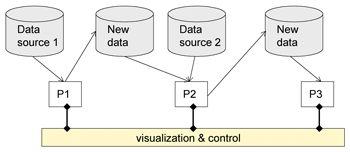gViz Project - Visualization Middleware for Grid Users
by Julian Gallop
gViz is one of the projects supported by the UK e-science programme. It aims to investigate the additional requirements to exploit visualization facilities on behalf of Grid users and sets out to provide visualization middleware to support this.
gViz began in August 2002 and was introduced in the article 'Visualization Middleware for e-science - a new project in the UK e-science programme' in ERCIM News issue 51.
Grid-Enabling Existing Visualization Systems
One strand in the project, being carried out by the University of Leeds, aims to build on an existing visualization system, enabling users to make effective use of the Grid's computational resources. Initially this is being done using the Iris Explorer dataflow visualization (from NAG).
The first stage predated the gViz and demonstrated how Iris Explorer could be used to wrap calls to the Globus library.
The second stage built on that and allowed the user to employ Iris Explorer's dataflow mechanisms to allocate modules to appropriate Grid resources, allowing a better user interface and better performance.
A further stage designed a Grid-based computational steering library which allows a wider range of applications to access the Grid through Iris Explorer. In addition it allows a visualization session to support the steering of short running computations, which may start and finish during a single session, or long running computations, which implies that the visualization session will need to connect to and disconnect from an already running computation. This gViz strand is described in more detail in [Wood03].
Use of XML for Visualization
Another strand of the project aims to use XML to support visualization and data analysis. One aspect of this is to support the transfer and reuse of a visualization application. A language SkML has been designed to describe the module invocations and data flows. This graph-based language can be mapped to the command language of particular visualization systems. This has been tested so far with Iris Explorer. In addition, an interactive graph editor has been written to support manipulation of the SkML language.
XML is also an appropriate tool for describing data about data. Increasingly, managers of significant data holdings are using XML as a descriptive mechanism. It can also be used to describe legacy data. This is an opportunity to set up mechanisms to enable visualization and data analysis systems to access the wide range of data already available, ideally without substantial change to those systems.
 |
| A possible processing chain. |
One result of these developments is that a visualization session could use a chain of processing elements, possibly with different data analysis systems and possibly in different locations on the Grid, according to the best use of resources. The figure illustrates this. For more detail of some of the ideas on using XML in the gViz project, see [Duce2002].
Applications
Within the project, certain applications will be used as testbeds and these include pollution monitoring, heart modelling (in computational biology) and climate prediction.
Partners
The academic partners are University of Leeds (lead partner), University of Oxford, Oxford Brookes University and CCLRC Rutherford Appleton Laboratory. Industrial partners are IBM UK, NAG Ltd. and Streamline Computing.
Links:
[Duce2002]: http://ewic.bcs.org/conferences/2002/euroweb/session3/paper1.htm
[Wood2003]: http://www.nesc.ac.uk/events/ahm2003/AHMCD/pdf/030.pdf
Project website: http://www.visualization.leeds.ac.uk/gViz/
Please contact:
Julian Gallop, CCLRC RAL
Tel: +44 1235 445569
E-mail: Julian.Gallop rl.ac.uk rl.ac.uk
|



